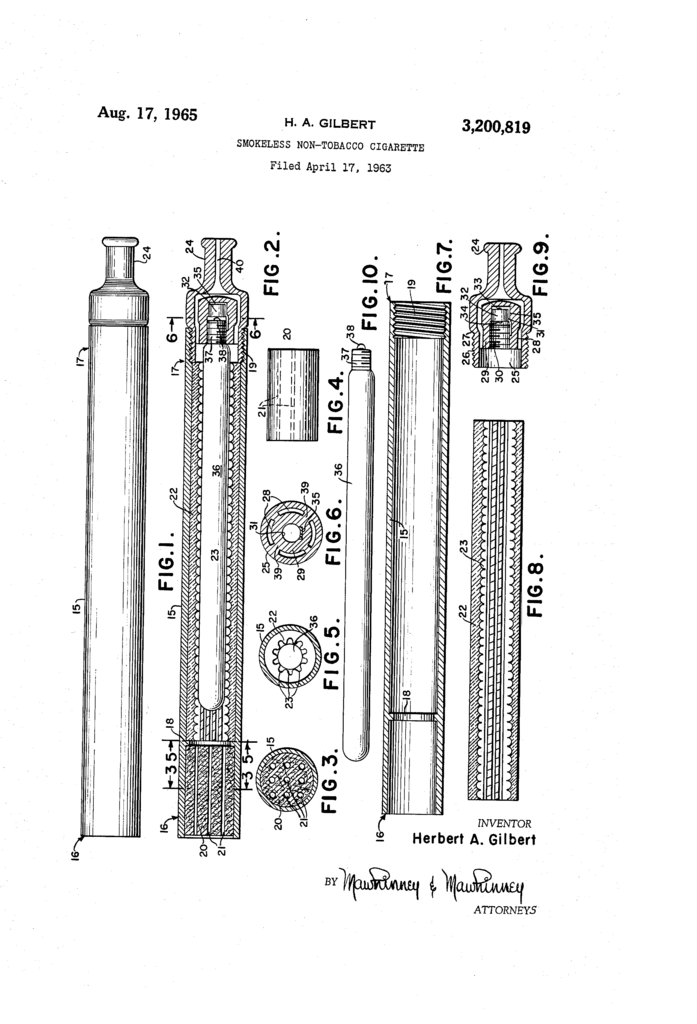The evolution of eLiquid
Vape juice, eLiquid, vape liquid, e juice...whatever you call it, there’s no doubt that it’s the thing that keeps us all wild about vaping. The sheer range of quality flavours; the wide choice of nicotine levels; the advancement of high VG e liquids that create competition grade clouds. Whatever your particular preference, you are sure to find an e-liquid to suit your taste and vaping style.
However, you might be surprised to learn that e liquid, in its most rudimentary form, dates back to the 1960s.
The invention of ‘eLiquid’
On 17th April 1963, a young business graduate from Pennsylvania, named Herbert A Gilbert, filed a patent for the world’s first electronic cigarette. He used a battery powered heat source, and flavoured water, to create a smokeless non-tobacco based e-cig.

Unfortunately, Mt Gilbert was ahead of his time, and the patent expired before he could realise commercial success. Tobacco companies were famous for heavily advertising their cigarettes as sexy, pleasurable objects that were endorsed by doctors and loved by the ladies! Nobody recognised the need for an alternative. Also, crucially, his version of eLiquid contained no nicotine.
The invention of ‘vaping’
Jump forward to 1979 when a Doctor by the name of Norman Jacobson worked with a computing genius called Philip Ray to find a vehicle to deliver nicotine to the bloodstream, via the lungs, but eliminated the other toxic ingredients found in cigarettes.
Their final device was not electronic at all. Although it very closely resembled a cigarette, there was no heat. A cartridge containing paper soaked in nicotine was placed inside a cigarette-like tube. Users would inhale to release the nicotine from the cartridge.
There was no flavour and, because there was no heat, there was also no vapour. So, for all intents and purposes, it wasn’t an e-liquid - yet this is the first record that we have of the word vaping being used to describe the process.
Dr Jacobson said during his presentation of the device,
“To simplify description, we will hereafter refer to nicotine vapour inhalation through a [non-combustible cigarette] as vaping and people who inhale nicotine vapour as vapers.”
Between then and the early 2000s, various tobacco companies worked towards creating a ‘safe’ version of the cigarette. The sticking point always seemed to come when looking how to market the product, as none were willing to publicly admit that normal cigarettes were ‘unsafe’. Consequently, we ended up with myriad nicotine replacement vehicles that bore no resemblance to cigarettes; such as gum and patches.
The pharmacist that gave us the e-cigarette
In the early 2000s, a Chinese pharmacist named Hon Lik was using these nicotine therapies to quit smoking; the habit that was killing his father. He realised that the only satisfactory way to satisfy his nicotine cravings was indeed smoking, and set about inventing a safer version.
His breakthrough moment came in 2003, when he had the idea of using ultrasound to vaporise a nicotine solution in a device that looked like a traditional cigarette. This process created droplets that were far too large to create a smoke-like vapour, so he added resistance heating which proved more successful.
The birth of the modern e-liquid
As a pharmacist, the process of testing liquids to create the right vapour was suited to his skillset. His lengthy experimentation process led him to propylene glycol - the PG that we still find in our vape juice today.
PG had many advantages: it holds nicotine well; it creates vapour when heated; it is odourless and flavourless so can have any flavour added; it has low viscosity so could easily be absorbed by the wick; and it was already approved by the FDA as suitable for use in food and pharmaceuticals.
Adding VG into the mix
Later, it was found that vegetable glycerine (VG) was just as effective as PG, but with the added advantage that it is hypoallergenic so doesn’t cause any adverse effects in people with PG sensitivity. Also, VG is thicker than PG, which creates more impressive vape clouds.
However, the more viscous quality means that users get less of a throat hit - the thing that most closely replicates smoking a cigarette. Since this discovery, manufacturers and vapers alike have been experimenting with various combinations of VG and PG to get the perfect balance of hit on the inhale, and vapour plumes on the exhale.
Vape Juice today
Few industries have seen an evolution rate at the pace of the vaping industry. Today we prefer high VG e liquid; we have ejuice that contains nicotine salts rather than freebase nicotine; we can buy ‘fizzy’ vape juice that resembles sherbet on the palette; we have started to ‘shake and vape’ using short fill, nicotine free vape liquid and nic shots to avoid the unnecessary waste associated with buying multiple 10ml bottles; some of us vapers even make our own DIY vape juice, buying flavourless e liquid and creating our own flavours.
You can check out all the latest e liquid trends for 2018 here.
Whatever your particular vape juice style - be it fizzy or menthol, high nicotine or nic free, high VG or high PG - there can be no doubt that every vaper is very well catered for. We should be thankful to those early pioneers for persevering and bringing us the vaping experience that we enjoy today.
